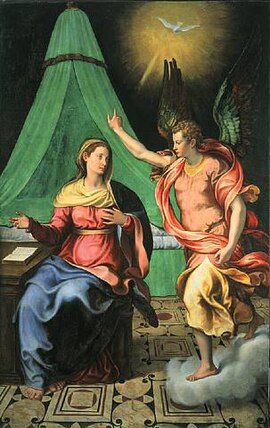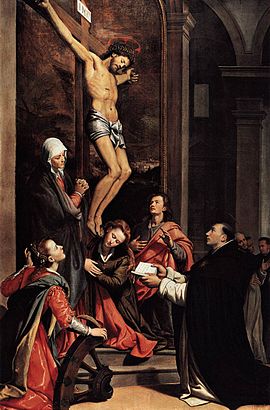


Counter-Maniera or Counter-Mannerism (variously capitalized and part-italicized) is a term in art history for a trend identified by some art historians in 16th-century Italian painting that forms a sub-category or phase of Mannerism, the dominant movement in Italian art between about 1530 and 1590. Counter-Maniera or Counter-Mannerism reacted against the artificiality of the second generation of Mannerist painters in the second half of the 16th century. It was in part due to artists wishing to follow the vague prescriptions for clarity and simplicity in art issued by the Council of Trent in its final session in 1563, and represented a rejection of the distortions and artificiality of high Mannerist style, and a partial return to the classicism and balance of High Renaissance art, with "clarity in formal order and legibility in content".[2]
The term was devised by the art historian Sydney Joseph Freedberg (1914–1997), and has gained a good degree of acceptance, although it is by no means universally adopted by other art historians. Counter-Maniera was one of the four phases of 16th-century Italian painting defined by Freedberg in his Painting in Italy, 1500–1600, first published in 1971 and long the standard textbook on the period, as: "First Maniera, High Maniera, Counter-Maniera and Late Maniera".[3] The styles did not neatly succeed each other but existed side by side for much of the time, with High Maniera remaining the dominant style during the main period of Counter-Maniera in the third quarter of the 16th century. In many cases Counter-Mannerism was a development of an artist's style in mid or late career, or a style used for some works, especially religious commissions, while other works by the same artist continued to use a high maniera style.[4]
Freedberg's contemporary Federico Zeri had in 1957 introduced or revived his own term arte sacra ("sacred art") for pre-Baroque Counter-Reformation style in Roman painting, overlapping to a large degree with Freedberg's Counter-Maniera, though rather wider in both the dates and styles included. The use of the term Counter-Maniera may be in decline, as impatience with such "style labels" grows among art historians. In 2000 Marcia B. Hall, a leading art historian of the period and mentee of Freedberg, was criticised by a reviewer of her After Raphael: Painting in Central Italy in the Sixteenth Century for her "fundamental flaw" in continuing to use this and other terms, despite an apologetic "Note on style labels" at the beginning of the book and a promise to keep their use to a minimum.[5]
- ^ San Marco, Florence [1]; cited as an example of "Counter-Mannerism" by Shearman, 178, in the only discussion of the style in his book
- ^ Freedberg, 429; his longest passage explaining his term is on pp. 429–430
- ^ Cropper, 17; Freedberg had used the terms in earlier articles.
- ^ Freedberg, 429–430
- ^ Murphy, 324